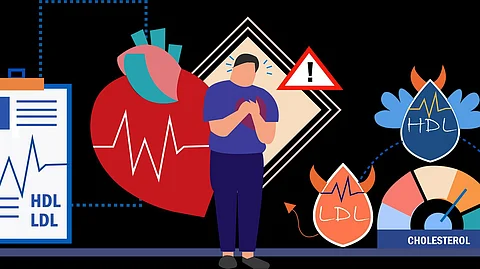

By Dr. Amey Patil
The world witnessed an epidemiological shift a few years ago as non-communicable diseases (NCD) surpassed communicable diseases. However, a group of non-communicable diseases has been brought to public attention for tragically taking young lives, the cardiovascular diseases.
Cardiovascular diseases (CVDs) are the leading cause of death globally. They include several conditions namely – coronary heart disease, congenital heart disease, cerebrovascular disease, rheumatic heart disease, peripheral arterial disease, pulmonary embolism, deep vein thrombosis, etc.
According to WHO, around 17.9 million people died from CVDs in 2019, which accounts for 32% of all global deaths. Out of the 17 million people who died under the age of 70 (premature deaths), 38% were due to CVDs.
CVDs can be prevented by addressing lifestyle factors like unhealthy diet and obesity. However, recently the prevalence of CVDs has been shockingly increasing among a group of individuals who are extremely fit and exercise regularly, the soccer players.
The association between Soccer and Cardiovascular diseases
The main risk factors of CVDs include an unhealthy diet, lack of physical activity, consumption of alcohol in higher quantities, and obesity. However, soccer players are surprisingly an exception to this trend. Soccer players are extremely fit and conditioned to play an intense game of around 90 minutes. Therefore, it’s baffling to see the rising number of deaths among soccer players by CVDs. Many studies have tried to correlate the association between soccer and cardiovascular diseases.
Studies have shown coronary artery disease (CAD) to be the most common cause of death among soccer players. According to a study, the prevalence of premature CAD was very high in young male football players with a mean age of around 24. The subjects were not even professional and played football as a recreation. A similar study in Turkey revealed that CAD was the main cause of CVDs. Severe CAD was observed in very young male athletes with a mean age of around 25.7 years old.
Main causes of cardiovascular deaths among soccer players
Studies were carried out by observing and recording soccer players. It was found that the players cover a distance of about 10-12 km throughout a game of 90 minutes. However, the game is extremely dynamic with players carrying out many actions along with running and jogging. The players perform dribbling, heading, tackling, and twisting of the torso to change direction which requires high intensity. Studies suggest that energy production required while playing soccer is dependent on aerobic mechanisms. However, the intensity can approach the anaerobic threshold at around 80-90% of maximum heart rate leading to sudden cardiac death.
One of the earlier incidents of sudden cardiac death (SCD) was of a 28 years-old, Marc Vivien Foe. He was a midfielder for the Cameroon national soccer team. The semi-final of the FIFA Confederations Cup was played between Columbia and Cameroon. During the 72nd minute of the match, Foe collapsed on the field. He died shortly after arriving at the medical centre. He was found to have Hypertrophic Cardiomyopathy (HCM). HCM is one of the common causes of sudden cardiac death.
Recently on 12 June 2020, then 28 years-old Christian Eriksen collapsed during a UEFA Euro 2020 game between Denmark and Finland. The medical team arrived immediately and cardiopulmonary resuscitation and defibrillation were performed on the field. Eriksen fortunately survived and made his return recently in March 2022 scoring in just 2 minutes.
Other incidences include the unfortunate death of a 22 years-old Antonio Puerta on 25th August 2007. Puerta’s autopsy revealed a CVD called Arrhythmogenic Right Ventricular Cardiomyopathy (ARVC). According to a study, ARVC is the second-highest risk of sudden cardiac death in Italy.
Measures moving forward
There should be certain guidelines to prevent the number of CVDs among soccer players. Total cardiovascular screening must be thoroughly carried out. It includes a physical examination, personal history, family history, and an echocardiogram. The stadiums should have trained medical and paramedical staff who are equipped to manage cardiovascular disease. The stadiums should also have automated external defibrillators (AEDs).
There should also be recommendations for decreasing the workload of soccer players. Soccer is the most popular sport in the world. However, too many tournaments are carried out throughout the world. This leads to increased physical and mental stress on the athletes. Stress can also lead to various conditions and is one of the risk factors for cardiovascular disease.
References –
• John P. Higgins and Aldo Andino, “Soccer and Sudden Cardiac Death in Young Competitive Athletes: A Review”, March 2013
• Sophie I. Mavrogeni, Konstantinos Tsarouhas, Flora Bacopoulou, et al, “Sudden cardiac death in football players: Towards a new pre-participaton algorithm”, November 2018
Dr. Amey Patil is an Ayurveda doctor by profession and currently pursuing Masters of Public Health from National Institute of Public Health, Mumbai.
